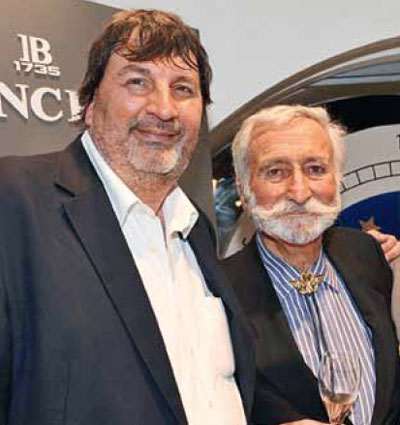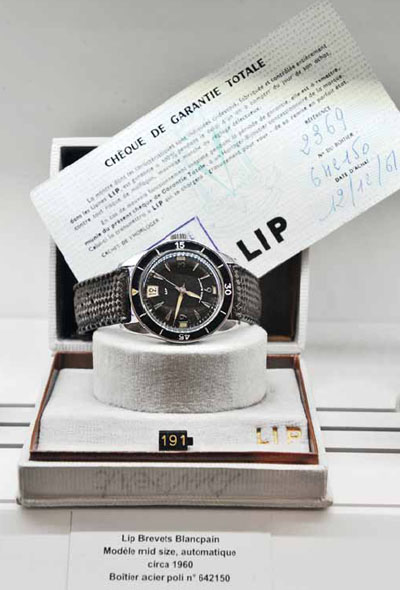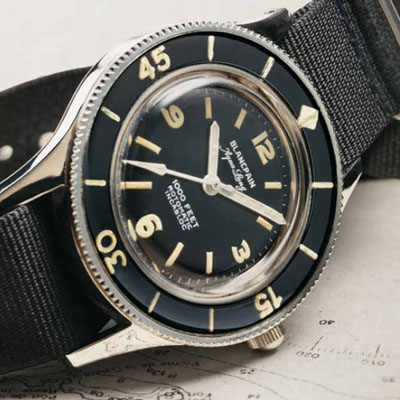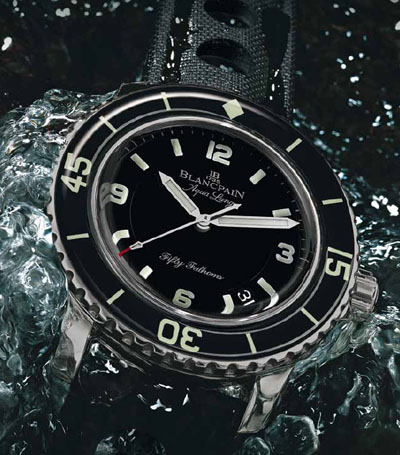Lettres du Brassus N°09Jeffrey S. KingstonThe watch was born of the passion of Blancpain's CEO, Jean-Jacques Fiechter, and, Robert Maloubier, the diving pioneer of the french navy. The at a time when the watch faded from the public limelight, a passionate quest by a french journalist, Stephan Ciejka brought attention back to this icon. Blancpain paid hommage to all of this in its fifty fathoms exhibition.

Stephan Ciejka did not start out to be a military historian. Nor for that matter did he initially aspire to become the world's leading expert on Blancpain's Fifty Fathoms watches. But through a bit of serendipity and prodigious amounts of dogged leg work, Stephan cemented his position as both. In process he placed himself in the nerve center of a network of devoted Fifty Fathoms collectors whose passions combined to enable the assembly of a once in a lifetime retrospective exhibition that traveled the world during Blancpain's 275th Anniversary celebration.
As with many later to become important enterprises, Stephan's initial steps portended little of what was to follow. In September 1986 he was assigned by a French news magazine to write an article setting out the life story of Bob Maloubier, co-founder of the French Navy's Combat Diver corps. Gazing at Stephan's wrist during their interview, which on that day sported a Rolex Submariner 5513 watch, Maloubier remarked “I worked on the creation of a diving watch much better than that!” What unfolded was Maloubier's recounting of how he came to work with Blancpain in the 1953 creation of the world's first modern diving watch, the Fifty Fathoms. To outfit the newly created French combat diving corps, Maloubier knew that one of the essential pieces of equipment for his teams would be a robust diving watch. In collaboration with Blancpain all of the specifications that have defined diving timepieces ever since were developed and incorporated into the Fifty Fathoms: large rotating and locking bezels, black and white color scheme with easy to read indexes, automatic winding, luminous markings, anti-magnetic protection and, of course, high watch resistance.
His interest ignited by the encounter with Maloubier, Ciejka embarked on a search to find some of these early Blancpain military watches. His initial efforts yielded little. Seemingly no one was then collecting these vintage navy timepieces or for that matter knew much of their history. His initial find, an old Fifty Fathoms bearing the trademark “LIP Blancpain” far from unraveling the mysteries only added to them. Why the name “LIP”? LIP was long ago a leading watch retailer in Paris and manufacturer in Besançon, but why the dual logo?

The first big break came when Ciejka found a shop in Marseille, Sub- Horlogerie, that specialized in the repair of diving watches. The proprietor long ago had been a partner of Blancpain selling Fifty Fathoms watches to divers. Far from treating the old watches as prized pieces of watchmaking history and recall there was at the time no active collector community—Sub-Horlogerie had simply dumped its accumulation of old Fifty Fathoms into a box and offered to sell the entirety to Ciejka. Steel yourself for this, if only I had been there, revelation. Ciejka bought the entirety of the box for a mere pittance!
Realizing that old military watches were the forgotten stepchildren in the vintage watch world, Ciejka turned his attention to Paris' famous Marché Aux Puces (the flea market located north of the city center near the Porte de Clignancourt. Pawing through bins of these underappreciated military gems, Ciejka gradually added to his collection with occasional big finds again with some of the watches sold for only one dollar. With a journalist's determination, Ciejka gradually began uncovering information sources on military watches. One discovery came in the Paris Marais district.
There Stephan encountered watchmaker Fernand Pechoin who offered an insight that greatly aided the quest. Previously working to repair watches for the French air force—and indeed a pilot himself—this watchmaker explained that to really get to the sources of information on military timepieces, one needed to center the search not upon the watches, but upon the military branch itself and, that further, each branch, army, navy, air force, had its own suppliers of timepieces.
Since this watchmaker was only interested in vintage aviation pieces, as an added bonus to their meeting, he simply gave Stephan a shoe box overflowing with diving watches. Now with a new path to pursue, namely the records of the French Navy, Stephan set about arranging access. The process was long and bureaucratic, but, fortunately, because he was a working journalist, Ciejka was finally accorded the appropriate press credentials giving him access to the archives of the French Navy. It was there that he uncovered roots of the development, not only of the Fifty Fathoms watch, but of the French combat divers themselves. This was a report written by Claude Riffault (a colleague of Robert Maloubier) describing the operations and tactics of the Italian combat divers, with whom Riffault and Maloubier collaborated at the end of the war. In the explanation of the Italian methods of attack, Riffault wrote of not only their tactics and techniques, but their equipment as well. One of the essential items for the divers enumerated in the report was a diving watch.

As a diligent journalist would do, Ciejka followed the leads from his unearthing of the navy report and met with Riffault. From that meeting he learned yet another piece of the puzzle, the pivotal role played by Jean-Jacques Fiechter, Blancpain's CEO from 1950-1982, who, a diver himself, developed the Fifty Fathoms. All the holes in the tapestry of the evolution of this now iconic diving timepiece were filled in by Fiechter. Fiechter explained how the Fifty Fathoms was sold through a variety of channels. Some were delivered directly to the military, initially the French navy but later other militaries around the world. Other models, conceived for civilian divers (versions that happily did not utilize radioactive coatings for luminosity which military specifications demanded) were sold through dive shops under various names including the name “Aqualung”. Still other versions were sold in the United States as “Tornek Rayville”, with “Tornek” being the name of the enterprising importer who secured a contract to supply the US Navy and “Rayville” being a name which Blancpain adopted for some of its production in the 1930's (Blancpain was founded in Villeret and Rayville was a word play on that name).
And, of course, the mystery of the LIP Blancpain watch, the first acquired by Ciejka was revealed.
LIP was a leading watch manufacture based in Besançon (located in the foothills of the Jura in France) in 1953 and was the first address which French combat divers sought out in their quest to find a suitable diving watch. LIP's suggestion was a small diameter timepiece, which when tested by Maloubier and Riffault leaked. Badly. When confronted with the complaint and requested to supply an alternative, LIP's response was that because aviation was in vogue, “there was no future in diving watches”. This sent Maloubier and Riffault on the search that led to Blancpain. Only later realizing that, indeed, there was a future in diving watches, LIP began to carry the Fifty Fathoms in its stores ordering the special edition that carried its name on the dial.

With the depth of his expertise, Ciejka played a role in the development of two modern Blancpain Fifty Fathoms pieces. During the early 90's as his research had given him an expertise unmatched by any private collector, Ciejka approached Blancpain's then CEO, Jean-Claude Biver. Biver had little interest in sport watches at the time. His attention was turned elsewhere, developing new complications for Blancpain's classically oriented collection. But as he was dogged in his research, Ciejka was persistent in pursuing Blancpain to issue a new version of the nearly half century old Fifty Fathoms. Finally Biver relented, spotting that sport watches were gaining interest in the market, and in the late 90's the Blancpain Trilogy collection was born which included as one of its three models, a new Fifty Fathoms.

No persuasion was needed for the development in 2003 of the 50th Anniversary edition of the Fifty Fathoms. Blancpain's CEO, Marc A. Hayek, himself a passionate diver, had already planned this special re-edition timepiece which introduced for the first time the luxury and robustness of a sapphire bezel. Although not instrumental in the development of this Anniversary edition, which has become itself a rare and intensely sought after collectors' piece, Ciejka played a significant role in the launch of the watch. Ciejka not only recounted the history of the Fifty Fathoms to Marc Hayek, he arranged the introduction of Robert Maloubier. Together Marc Hayek and Robert Maloubier traveled to Thailand diving together to formally launch the new Fifty Fathoms on the watch market.With his thirty year devotion to unearthing the Blancpain's half century Fifty Fathoms patrimony, it was natural that Blancpain turned to Ciejka when it decided to create a special Fifty Fathoms exhibit as part of the 275th Anniversary celebration. As Blancpain itself over this 50 year span had not retained examples of the varieties of the time pieces which it had produced, it was known at the outset that it would have to turn to private collectors to assemble the exhibit.
Ciejka was willing to reach out to what was now his deep network of other savvy aficionados who had come to share his passion for the important role that military timepieces such as the Fifty Fathoms played in the history of watchmaking, but nobody knew what the response would be. How would these collectors react when asked to loan their irreplaceable vintage Fifty Fathoms watches to Blancpain? Would they really be willing to part with their prized timepieces for the several month period of the exhibit? Why would they do it? How many would respond with a “yes”? Sitting in Blancpain's offices discussing the plan, the optimists in the gathering hoped that perhaps as many as 30 watches would be loaned for the exhibit.No one was as giddy an optimist to have predicted the response. Over 100! collectors responded in the affirmative to Blancpain's appeal to loan their watches for the exhibit.
Three times the most optimistic guess before the program rolled out. Far from being reluctant to part with their vintage pieces for several months while the exhibit was shown beginning on Place Vendome in Paris and then traveling to China, both coasts of the US, and finally going on display in Blancpain's booth in Basel, the collector community was proud to see their watches displayed. A lot had changed since Ciejka had started his investigation more than 30 years ago. The world had woken up. What had previously been outcast military timepieces unceremoniously tossed into shoe boxes and forgotten, were now sought after collectors' items. Unselfishly, the collectors knew that thousands of people should see this important part of watchmaking history.

Of course the Fifty Fathoms exhibit was for the collectors too. More than 100 collectors and guests descended on the Place Vendome in Paris for a special evening in their honor. Yes, the champagne flowed but this was no ordinary soiree of toothy grins and airy small talk. This crowd was here see the watches, take pride in pointing out their own pieces in the glass cases and to exchange endless stories on the histories of the individual watch models and how the owners came to find them. None of the stories was more riveting that those of Robert Maloubier. Now the broad community of Fifty Fathoms devotees could learn what Stephan Ciejka had unearthed in his 30 years of journalistic investigation. Maloubier told of his first sinking of a ship during combat dive, recounted in the same tone as a fisherman spinning a tale of landing a big one, only in this case instead of a sport fish, it was a ship. His tale included the failed experiment with the tiny LIP watches that leaked, the search for a watch company that would work with him and the collaboration with Blancpain's Jean-Jacques Fiechter.
What was most profoundly in evidence at that gathering was sense of adventure that bound together the crowd in the room. Ciejka explained it best. Collecting these Fifty Fathoms timepieces extends to something broader than the watches themselves. The watch is a window into history that leads to events and the people behind the events. And so the Fifty Fathoms in its half century of evolution not only represents the first modern diving watch and the template that it became defining and shaping diving watches for the entire industry ever since, it carries with it the lore of the early military diving and the French navy's pioneering work.





